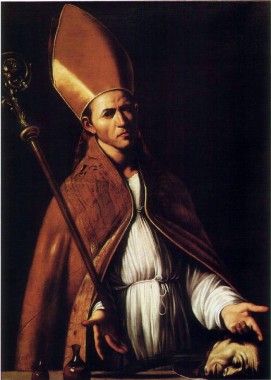Today is the feast of St Januarius, also known as San Gennaro. The streets of Little Italy in New York City are filled with festival goers, eating Italian foods and all sorts of yummy things.
Do you think if you stopped any one of these party-goers on the street and asked them who San Gennaro is and why a whole day is dedicated to his memory… would they know? Maybe. Maybe not. But hey! The Communion of Saints is large and seemingly endless, so it’s impossible for anyone to know about all of the saints, right? Still, a saint’s feast day is a great opportunity to learn more about him or her, so let’s get to it.
Who is St Januarius?
 As often happens with saints from the early days of the Church, we don’t know a lot about St Januarius. But here’s what we do know.
As often happens with saints from the early days of the Church, we don’t know a lot about St Januarius. But here’s what we do know.
He was born in Benevento (known then as Beneventum) near Naples sometime in the 3rd Century (we don’t know when), when Latin was the main language of Italy, so odds are his mom and dad called him Januarius.
He became the bishop of Benevento and, one day in 305 AD, he was arrested, along with six other companions –Festus, Desiderius, Sossus, Proculus, Euticius, and Acutius–for being Christian.
Legend has it that they were thrown to wild animals in the Flavian Amphitheater at Pozzuoli–some say bears, others say lions–and that the animals refused to eat the holy men. Another legend says he was thrown into a fiery furnace and emerged unharmed. In the end, St Januarius and his companions were publicly beheaded.
Here’s the story behind that: at the time, Diocletian was Roman Emperor, loyal to the pagan gods. Some time in 299 A.D, Diocletian went to someone to predict the future for him by sacrificing an animal and reading the entrails. The fortune teller couldn’t do it, blaming all of the Christians in the Imperial household… and thus began an Empire-wide persecution of Christians. (It’s amazing what one person can do.) Diocletian demanded that all Christians perform sacrifices, and if they didn’t, they were killed in one gruesome way or another.
As Tertullian famously wrote, “the blood of the martyrs is the seed of the Church.” Despite religious persecution that lasted for twelve years (from 299 until 311, when the edict was rescinded), many Christians escaped martyrdom, and in 306 AD, one year after Diocletian’s death, Constantine (later to be called “the Great) was named Emperor. He decreed a formal end to the Christian persecution, and later converted to Christianity.
The Blood of the Martyrs
The story of St Januarius does not end there.
Legend tells us that after his martyrdom, someone decided to soak up his blood with a sponge–enough to fill two glass phials.
When St Januarius’ remains were transferred to the catacombs in Naples, the dried blood in the phials miraculously liquefied. Since that first miracle, it’s said that St Januarius’ bottled blood liquefies a few times a year, and today, September 19th, his feast day and the anniversary of his martyrdom, is one of them.
St Alphonsus Liguori says,
“The Neapolitans honor this saint as the principal patron of their city and nation, and the Lord himself has continued to honor him, by allowing many miracles to be wrought through his intercession, particularly when the frightful eruptions of Mount Vesuvius have threatened the city of Naples with utter destruction. While the relics of St. Januarius were being brought in procession towards this terrific volcano, the torrents of lava and liquid fire which it emitted have ceased, or turned their course from the city. But the most stupendous miracle, and that which is greatly celebrated in the church, is the liquefying and boiling up of this blessed martyr’s blood whenever the vials are brought in sight of his head. This miracle is renewed many times in the year, in presence of all who desire to witness it; yet some heretics have endeavored to throw a doubt upon its genuineness, by frivolous and incoherent explanations; but no one can deny the effect to be miraculous, unless he be prepared to question the evidence of his senses.” —Victories of the Martyrs
And Blessed John Henry Cardinal Newman says,
“I think it impossible to withstand the evidence which is brought for the liquefaction of the blood of St. Januarius at Naples and for the motion of the eyes in the pictures of the Madonna in the Papal States.” —Lectures on the Present Position of Catholics in England
Today, St Januarius’ blood is kept at the Cathedral in Naples.
When Pope Francis visited Naples this past March, the blood liquefied a little. The Pope made a joke of it, saying, “It seems that the saint loves us a little. Perhaps we need to convert a little more for him to love us completely!” (Watch a video at the link.)
Raise Your Gelato Cone!
For the past 89 years, the area around Mulberry Street in New York City–famously known as Little Italy–has held a feast in honor of St Januarius–except here they call him San Gennaro.
But why here?
It seems that, back in the day, when Italians made their way to the New World, many Neapolitans settled in this area, bringing their beloved saint with them. Here, they continued the celebrations of their patron saint, and eventually, it became one of the city’s best-known celebrations.
The festival has a website–www.sangennaro.org–that lists events and celebrities at the event. But today, being San Gennaro’s actual feast day, they’re pulling out the big Catholic guns. If you’re in New York City today, get to Little Italy!
- 2:00-3:00 PM: High Mass in honor of San Gennaro at the Church of the Most Precious Blood at 109 Mulberry Street
- 3:00 PM: Procession of the Statue of San Gennaro through the streets of Little Italy
- 4:00 PM: Unveiling of the world’s largest gelato cone…
Well… even the saints had to eat, too, right?! And, after all, it’s a celebration! Mangia! If you can make it, you’re sure to find some of the city’s best Italian/Italian-American food, like sausages, zeppole, and more!
Art: San Gennaro mostra le sue reliquie (St Januarius shows his own relics), Michelangelo Merisi da Caravaggio, 1607, PD-US, Wikimedia Commons.





